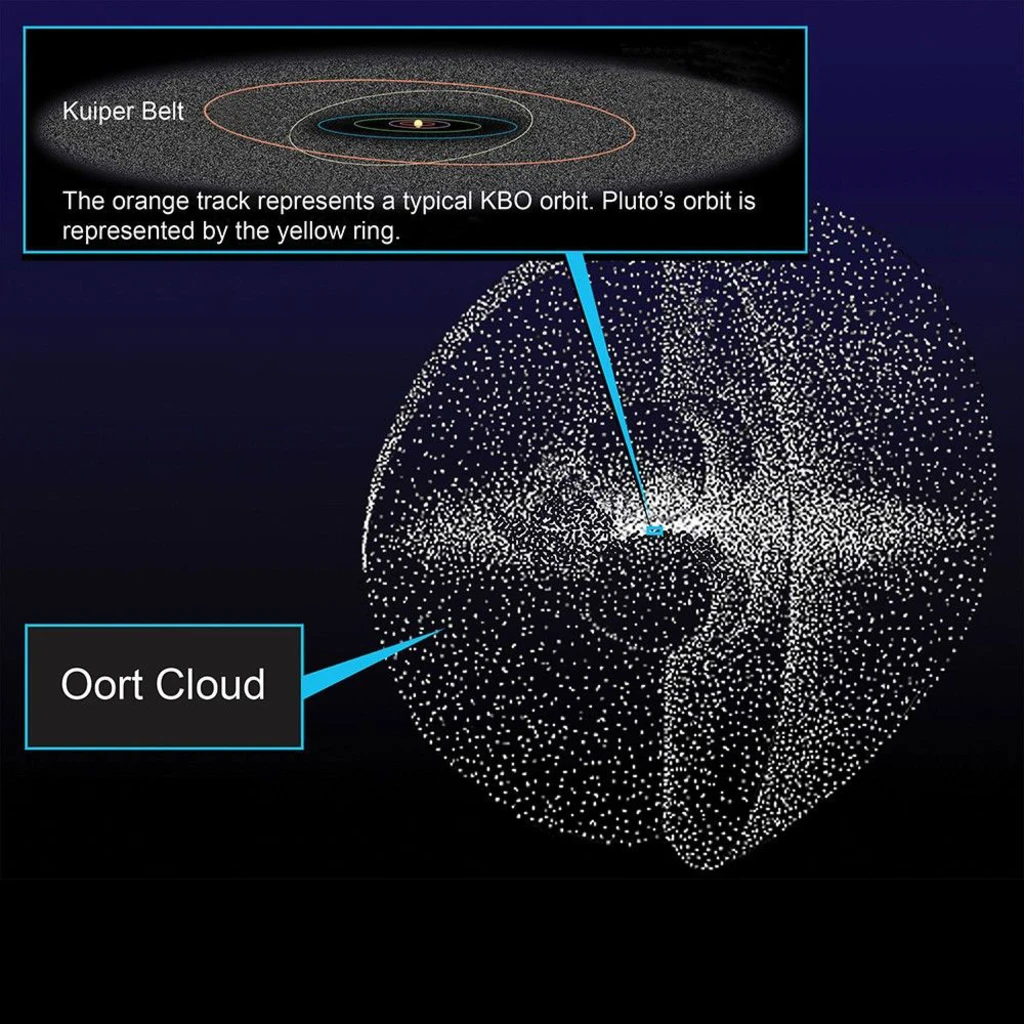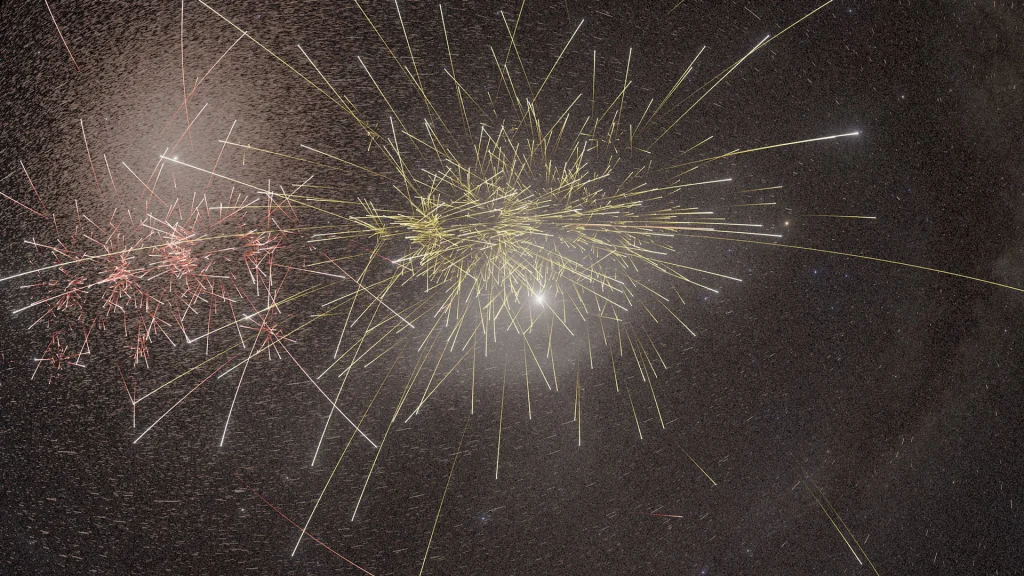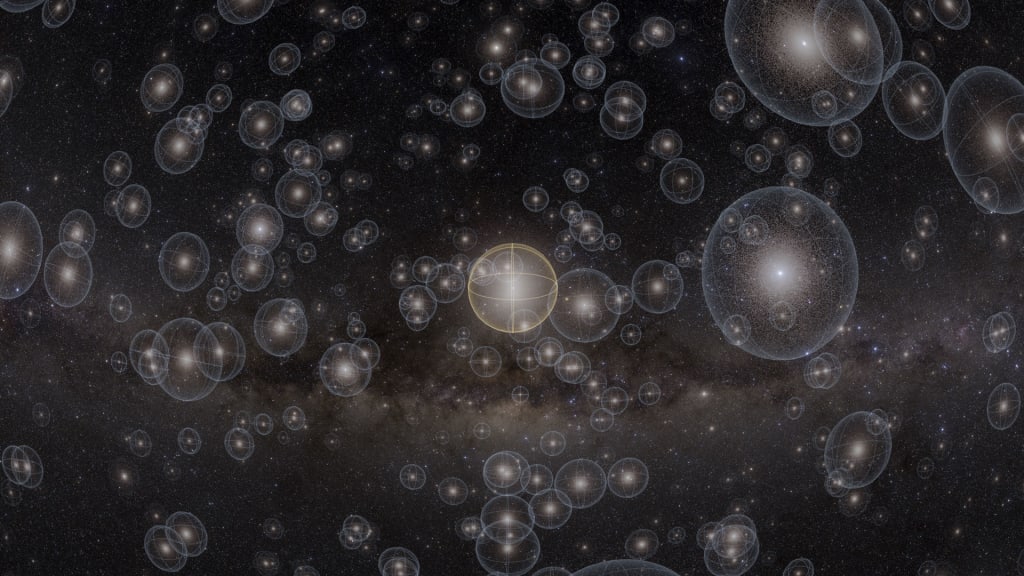In the event you’ve ever flown via outer house, no less than whereas watching a documentary or a science fiction movie, you’ve seen how artists flip astronomical findings into gorgeous visuals. However within the strategy of visualizing information for his or her newest planetarium present, a manufacturing staff at New York’s American Museum of Pure Historical past made a shocking discovery of their very own: a trillion-and-a-half mile lengthy spiral of fabric drifting alongside the sting of our photo voltaic system.
“So it is a actually enjoyable factor that occurred,” says Jackie Faherty, the museum’s senior scientist.
Final winter, Faherty and her colleagues had been beneath the dome of the museum’s Hayden Planetarium, fine-tuning a scene that featured the Oort cloud, the massive, thick bubble surrounding our Solar and planets that’s crammed with ice and rock and different remnants from the photo voltaic system’s infancy. The Oort cloud begins far past Neptune, round one and a half gentle years from the Solar. It has by no means been instantly noticed; its existence is inferred from the conduct of long-period comets getting into the interior photo voltaic system. The cloud is so expansive that the Voyager spacecraft, our most distant probes, would want one other 250 years simply to succeed in its interior boundary; to succeed in the opposite facet, they would want about 30,000 years.
The 30-minute present, Encounters in the Milky Way, narrated by Pedro Pascal, guides audiences on a visit via the galaxy throughout billions of years. For a piece about our nascent photo voltaic system, the writing staff determined “there’s going to be a fly-by” of the Oort cloud, Faherty says. “However what does our Oort cloud appear like?”
To seek out out, the museum consulted astronomers and turned to David Nesvorný, a scientist on the Southwest Analysis Institute in San Antonio. He supplied his mannequin of the hundreds of thousands of particles believed to make up the Oort cloud, based mostly on in depth observational information.
“Everyone mentioned, go speak to Nesvorný. He’s acquired the very best mannequin,” says Faherty. And “all people advised us, ‘There’s construction within the mannequin,’ so we had been type of set as much as search for stuff,” she says.
The museum’s technical staff started utilizing Nesvorný’s mannequin to simulate how the cloud developed over time. Later, because the staff projected variations of the fly-by scene into the dome, with the digital camera trying again on the Oort cloud, they noticed a well-known form, one which seems in galaxies, Saturn’s rings, and disks round younger stars.
“We’re flying away from the Oort cloud and out pops this spiral, a spiral form to the skin of our photo voltaic system,” Faherty marveled. “An enormous construction, hundreds of thousands and hundreds of thousands of particles.”
She emailed Nesvorný to ask for “extra particles,” with a render of the scene connected. “We seen the spiral in fact,” she wrote. “After which he writes me again: ‘what are you speaking about, a spiral?’”
Extra simulations ensued, this time on Pleiades, a strong NASA supercomputer. In high-performance pc simulations spanning 4.6 billion years, ranging from the Photo voltaic System’s earliest days, the researchers visualized how the preliminary icy and rocky elements of the Oort cloud started circling the Solar, within the elliptical orbits which might be thought to present the cloud its tough disc form. The simulations additionally included the physics of the Solar’s gravitational pull, the influences from our Milky Way galaxy, and the actions of the comets themselves.
In every simulation, the spiral continued.
“Nobody has ever seen the Oort construction like that earlier than,” says Faherty. Nesvorný “has an excellent quote about this: ‘The mathematics was all there. We simply wanted the visuals.’”

Because the Oort cloud grew with the early photo voltaic system, Nesvorný and his colleagues hypothesize that the galactic tide, or the gravitational drive from the Milky Approach, disrupted the orbits of some comets. Though the Solar pulls these objects inward, the galaxy’s gravity seems to have twisted a part of the Oort cloud outward, forming a spiral tilted roughly 30 levels from the airplane of the photo voltaic system.
“Because the galactic tide acts to decouple our bodies from the scattered disk it creates a spiral construction in bodily house that’s roughly 15,000 astronomical models in size,” or round 1.4 trillion miles from one finish to the opposite, the researchers write in a paper that was printed in March in the Astrophysical Journal. “The spiral is long-lived and persists within the interior Oort Cloud to the current time.”
“The physics is sensible,” says Faherty. “Scientists, we’re wonderful at what we do, nevertheless it doesn’t imply we are able to see every thing immediately.”
It helped that the staff behind the house present was primed to search for one thing, says Carter Emmart, the museum’s director of astrovisualization and director of Encounters. Astronomers had described Nesvorný’s mannequin as having “a construction,” which intrigued the staff’s artists. “We had been additionally searching for construction in order that it wouldn’t simply be form of like a giant blob,” he says. “Different fashions had been additionally revealing this—however they simply hadn’t been visualized.”
The museum’s makes an attempt to simulate nature date again to its first habitat dioramas within the early 1900s, which introduced guests to locations that hadn’t but been captured by shade pictures, TV, or the online. The planetarium, an evening sky simulator for generations of would-be scientists and astronauts, acquired its begin after financier Charles Hayden purchased the museum its first Zeiss projector. The planetarium now boasts one of many world’s few Zeiss Mark IX techniques.
Nonetheless, lately the star projector isn’t used, Emmart says, now that fulldome laser projectors can flip the outdated static starfield into 3D video working at 60 frames per second. The Hayden boasts six custom-built Christie projectors, a part of what the museum’s former president known as “the most advanced planetarium ever attempted.”

Emmart recollects how in 1998, when he and different museum leaders had been imagining the way forward for house reveals on the Hayden—now with the assistance of digital projectors and pc graphics—there have been questions over how a lot house they may attempt to present.
“We’re speaking about these astronomical information units we may plot to make the galaxy and the celebs,” he says. “In fact, we knew that we’d have this star projector, however we actually wished to emphasise astrophysics with this dome video system. I used to be drawing photos of this simply to get our heads round it and noting the tip of the photo voltaic system to the Milky Approach is about 60 levels. And I mentioned, what are we gonna do after we get exterior the Milky Approach?’
“Then [planetarium’s director] Neil Degrasse Tyson “goes, ‘whoa, whoa, whoa, Carter, we now have sufficient to do. And simply plotting the Milky Approach, that’s laborious sufficient.’ And I mentioned, ‘effectively, after we exit the Milky Approach and we don’t see every other galaxies, that’s form of like astronomy in 1920—we thought perhaps the whole universe is only a Milky Approach.’”
“And that type of led to a chaotic dialogue about, effectively, what different information units are there for this?” Emmart provides.
The museum labored with astronomer Brent Tully, who had mapped 3500 galaxies past the Milky Approach, in collaboration with the Nationwide Middle for Tremendous Computing Functions. “That was it,” he says, “and that appeared fantastical.”
By the point the primary planetarium present opened on the museum’s new Rose Middle for Earth and Area in 2000, Tully had broadened his survey “to an incredible” 30,000 galaxies. The Sloan Digital Sky Survey adopted—it’s now at information launch 18—with six million galaxies.
To construct the map of the universe that underlies Encounters, the staff additionally relied on information from the European Area Company’s house observatory, Gaia. Launched in 2013 and powered down in March of this 12 months, Gaia introduced an unprecedented precision to our astronomical map, plotting the gap between 1.7 billion stars. To visualise and render the simulated information, Jon Parker, the museum’s lead technical director, relied on Houdini, a 3D animation instrument by Toronto-based SideFX.
The purpose is immersion, “whether or not it’s in entrance of the buffalo downstairs, and seeing what these herds had been like earlier than we decimated them, to coming on this room and being teleported to house, with an correct basis within the science,” Emmart says. “However the artwork is vital, as a result of the artwork is the best way to the soul.”
The museum, he provides, is “a testomony to surprise. And I feel surprise is a gateway to inspiration, and inspiration is a gateway to motivation.”
Three-D visuals aren’t simply highly effective instruments for speaking science, however more and more essential for science itself. Software program like OpenSpace, an open supply simulation instrument developed by the museum, together with the rising availability of high-performance computing, are making it simpler to construct extremely detailed visuals of ever bigger and extra advanced collections of information.
“Anytime we glance, actually, from a unique angle at catalogs of astronomical positions, simulations, or exploring the section house of a posh information set, there may be nice potential to find one thing new,” says Brian R. Kent, an astronomer and director of science communications at Nationwide Radio Astronomy Observatory. “There’s additionally a wealth of astronomics tatical information in archives that may be reanalyzed in new methods, resulting in new discoveries.”
Because the devices develop in dimension and class, so does the info, and the problem of understanding it. Like all scientists, astronomers are dealing with a deluge of information, starting from gamma rays and X-rays to ultraviolet, optical, infrared, and radio bands.

“New services just like the Subsequent Era Very Massive Array right here at NRAO or the Vera Rubin Observatory and LSST survey venture will generate giant volumes of information, so astronomers must get inventive with the right way to analyze it,” says Kent.
Extra information—and new devices—can even be wanted to show the spiral itself is definitely there: there’s nonetheless no recognized strategy to even observe the Oort cloud.
As an alternative, the paper notes, the construction must be measured from “detection of numerous objects” within the radius of the interior Oort cloud or from “thermal emission from small particles within the Oort spiral.”
The Vera C. Rubin Observatory, a strong, U.S.-funded telescope that not too long ago started operation in Chile, may presumably observe particular person icy our bodies throughout the cloud. However researchers expect the telescope will seemingly uncover solely dozens of those objects, perhaps a whole bunch, not sufficient to meaningfully visualize any shapes within the Oort cloud.
For us, right here and now, the 1.4 trillion mile-long spiral will stay confined to the within of a darkish dome throughout the road from Central Park.


